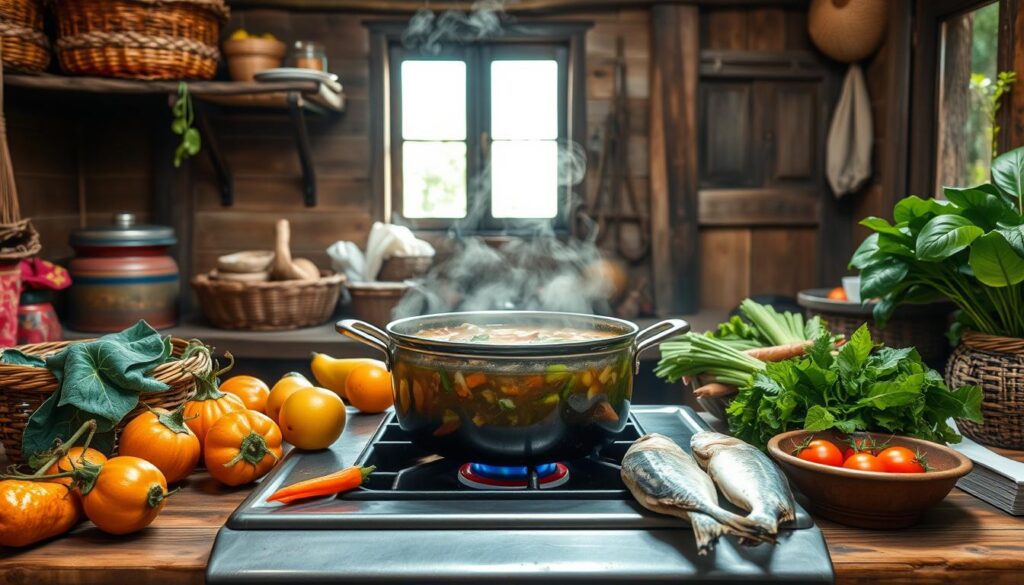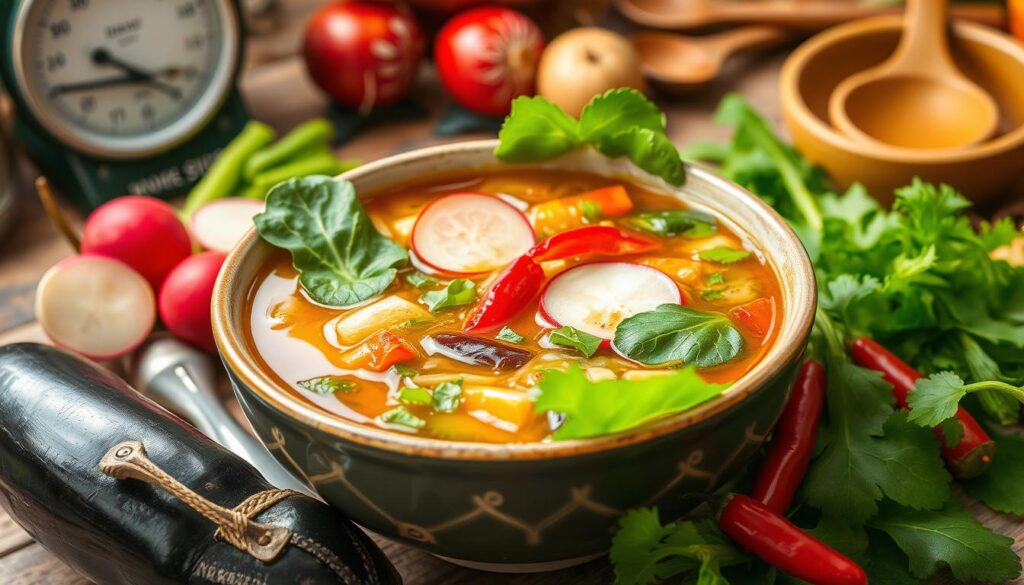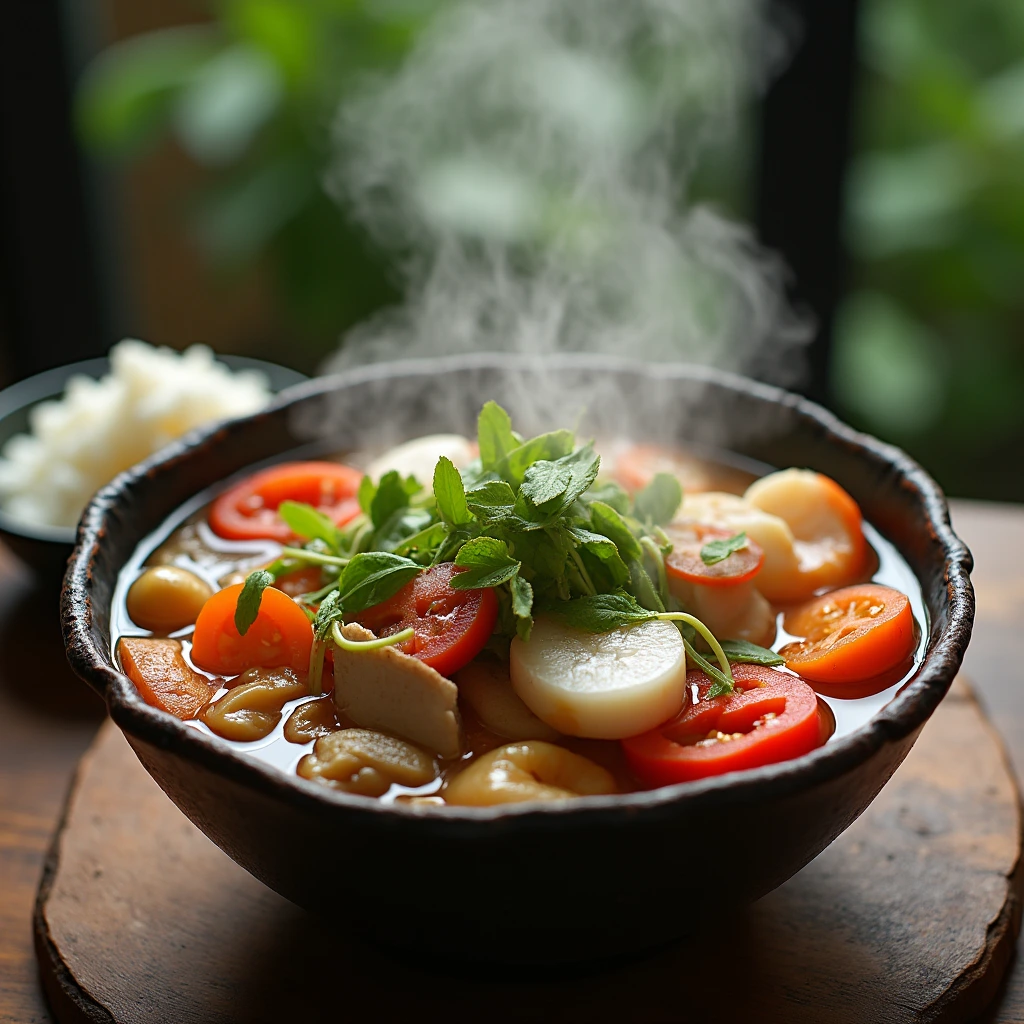Sinigang is a traditional Filipino soup known for its sour taste, thanks to tamarind. It’s not just tasty but also packed with nutrients. This makes it a favorite for those seeking a healthy yet flavorful meal. We’ll look into how sinigang can help with weight loss.
It’s made with fresh ingredients like proteins, veggies, and souring agents. This makes sinigang a great addition to any diet.

We’ll explore sinigang’s properties and ingredients to see how it fits into weight loss plans. It’s a beloved dish in Filipino homes. Let’s dive into this culinary treasure and see how it can be a healthy part of your meals.
Key Takeaways
- Sinigang offers a deliciously sour flavor, primarily from tamarind.
- It can be prepared with various proteins, including pork, chicken, and seafood.
- This Filipino soup is rich in vegetables that enhance its nutritional profile.
- It is celebrated for its low calorie count and high fiber content.
- Traditional prep methods ensure sinigang is both tasty and healthy.
Understanding Sinigang: A Filipino Culinary Treasure
Sinigang is a beloved dish in Filipino cuisine. It’s known for its unique taste and deep history. The dish’s roots go back to before the Spanish came, when people stewed meats with sour ingredients.
The key to sinigang’s tangy taste is tamarind. It’s mixed with pork and many vegetables. This mix creates a flavor that’s both sour and rich.

Sinigang’s history shows its importance in Filipino families. New ingredients like tomatoes were added during the Spanish rule. This made the dish even more popular.
Sinigang is more than just food. It brings families together during special times. It’s a symbol of unity and joy.
Every region in the Philippines has its own sinigang style. Places like Sinampalukang Manok and Sinigang na Baboy sa Bayabas use local ingredients. These dishes show the diversity of Filipino cooking.
Sinigang is also loved for its flexibility. You can make it with seafood or vegetables. This makes it a dish that’s always changing yet always true to its sinigang history.
It’s not just a meal; it’s a way to connect with Filipino culture. It shows the community’s spirit and pride in their heritage.
The Health Benefits of Sinigang
Sinigang is more than a tasty Filipino soup. It’s full of fresh veggies and lean protein. This makes it a great choice for your health.
This soup is rich in dietary fiber. It helps with digestion and keeps your heart healthy. Spinach, kangkong, okra, and eggplant add flavor and help prevent heart disease and stroke.
Sinigang also has potassium and phosphorus. These nutrients are key for blood pressure and bone health. The souring agent, like tamarind, boosts the soup’s nutritional value.
Tamarind is full of vitamin C and antioxidants. These help strengthen your immune system. With only 80 to 120 calories, Sinigang is perfect for those watching their weight.
| Nutritional Component | Amount per Serving |
|---|---|
| Calories | 80-120 |
| Protein | 18 grams (pork) / 26 grams (beef) |
| Fiber | Varies (from vegetables) |
| Sodium | Can exceed 1900 mg (depending on soup mix) |
| Potassium | High (helps regulate blood pressure) |
Sinigang is a standout in Filipino cuisine. It’s both delicious and nutritious. Adding it to your meals can help you eat more healthily.

Is Sinigang Good for Weight Loss
Sinigang is a great choice for those trying to lose weight. It’s a nutritious soup for weight loss that tastes amazing and is low in calories. It’s full of healthy ingredients and can help you manage your weight.
Low in Unhealthy Fats
Sinigang uses lean proteins like fish or shrimp. This makes it a low-fat soup option. Fish like milkfish or tilapia add omega-3 fatty acids, which are good for your heart without adding bad fats.
High Nutrition Density
Sinigang is filled with veggies like water spinach, radishes, and eggplant. These veggies are packed with vitamins and minerals. This makes sinigang a tasty and nutritious choice without extra calories. It’s a nutritious soup for weight loss because it’s full of Vitamin A and C.
Rich in Fiber from Vegetables
The veggies in sinigang are high in fiber. Spinach and okra help you feel full longer. This can help you eat less throughout the day. Sinigang is a healthier choice than heavy meals, keeping your diet balanced without losing flavor.
| Nutritional Component | Amount per Serving | Daily Value % |
|---|---|---|
| Calories | 286 | 14% |
| Total Fat | 17g | 22% |
| Saturated Fat | 2g | 10% |
| Carbohydrates | 9g | 3% |
| Dietary Fiber | 2g | 7% |
| Protein | 25g | 50% |
| Vitamin A | 1403 IU | 28% |
| Sodium | 262mg | 11% |
| Potassium | 652mg | 14% |
Key Ingredients in Sinigang
Sinigang is a favorite Filipino vegetable soup known for its rich flavors and health benefits. Its taste comes from the special ingredients used. These include a protein, various vegetables, and a souring agent.
Common Vegetables Used
Vegetables are key in sinigang, adding flavor and nutrients. Some favorites are:
- Tomatoes
- Spinach
- Daikon radish
- Eggplant
- Okra
- Long green beans (Snake beans)
- Water spinach (Kangkong)
These veggies make the soup colorful and nutritious, perfect for any meal.
Protein Sources: Meat, Seafood, and Vegetarian Options
Sinigang offers many protein choices, catering to everyone’s taste. Popular proteins are:
- Pork (often pork belly)
- Fish (such as bangus or tilapia)
- Shrimp (sinigang na hipon)
- Tofu for vegetarian options
Choosing a protein changes the soup’s flavor but keeps its traditional taste.
Variations with Souring Agents
The sour taste of sinigang comes from souring agents. Common ones are:
- Tamarind (most traditional)
- Fresh guava
- Lemon or lime juice
This variety lets cooks adjust the soup’s tartness to their liking, making each bowl special.
Making Sinigang: A Healthy Recipe
Making sinigang is fun and takes about 30 minutes. You spend 15 minutes getting ready and 15 minutes cooking. This Filipino dish is full of flavor and good for you. Learning to make sinigang lets you enjoy it at home.
Prep and Cook Times
The sinigang recipe is easy. It takes 15 minutes to prepare and 15 minutes to cook, for a total of 30 minutes. If you use pork spare ribs, cook them for about 45 minutes until they’re tender.
Basic Ingredients
Here are the main ingredients for a great sinigang:
- 2 lbs. pork belly or shrimp for seafood versions
- 8 cups water
- 2 packs of Knorr Sinigang sa Sampaloc Mix.original
- 3 tablespoons fish sauce
- 1/4 teaspoon ground black pepper
- Vegetables such as kangkong leaves, taro, daikon radish, okra, long green chili peppers, snake beans, and tomatoes
Step-by-Step Instructions
Here’s how to make your sinigang:
- In a large pot, boil 8 cups of water.
- Add the pork belly and boil for 25-30 minutes over low to medium heat.
- After the pork is tender, throw in the taro and cook for about 20-30 minutes.
- Introduce the daikon radish and let it cook for an additional 5 minutes.
- Add the remaining vegetables: okra, snake beans, long green chili peppers, and tomatoes.
- Season the broth with the Knorr mix, fish sauce, and black pepper.
- Simmer the soup until all vegetables are tender, then serve hot with rice or cauliflower rice.
Alternative Ingredients for Sinigang
Looking to make your sinigang your own? Try new ingredients to boost flavor and fit your diet. This Filipino soup can be tailored to your taste, making it both tasty and healthy.
Substituting Meat for a Healthier Option
Want a healthier sinigang? Use tofu as a meat substitute. It’s packed with protein and keeps the dish plant-based. Add veggies like eggplant, okra, and bok choy for more nutrition and flavor.
This change is great for vegetarians and anyone looking for a lighter meal. It’s a win-win for everyone.
Using Fresh vs. Powdered Souring Agents
Choosing between fresh and powdered tamarind changes sinigang’s taste. Fresh tamarind gives a lively, vibrant flavor. Powdered tamarind is quicker but still flavorful.
Deciding on a souring agent can make your sinigang special. It’s all about finding what you like best.
Why Sinigang is a Great Choice for Meal Prep
Sinigang is a top pick for meal prep because it’s easy to store and customize. Making it in big batches lets you enjoy its tasty flavors all week. It’s also great for different diets, making it perfect for everyone.
Freezing and Storing Sinigang
Freezing sinigang right is key to keeping it fresh. Use airtight containers to store it. Cool the soup down first before freezing. This way, you can have a healthy meal ready to go any day.
Customizing Your Sinigang for Different Diets
Customizing sinigang is a big plus. You can change ingredients to meet dietary needs. Use lean proteins like shrimp or plant-based for a vegan option. Adjust the veggies to your liking or what’s in season. This lets everyone enjoy this Filipino favorite, fitting their diet.
Comparing Sinigang with Other Soups
When we compare sinigang and tom yum, we see a clash of flavors and health benefits. Each soup has its own special taste and health perks. Sinigang is known for its tangy flavor from tamarind, making it stand out.
This soup not only delights our taste buds but also shines in nutritional value.
Sinigang vs. Tom Yum: A Taste Comparison
Sinigang is called the world’s best vegetable soup by Taste Atlas. It offers a mix of sour and savory that many find refreshing. Tom yum, on the other hand, is a hot and sour Thai soup with aromatic flavors from lemongrass, fish sauce, and lime.
While both soups are loved, sinigang’s zestiness is unique compared to tom yum’s flavors.
Nutritional Value Comparison with Other Popular Soups
A look at nutrition shows sinigang has fewer calories and unhealthy fats than many soups, including tom yum. Each serving of sinigang has:
| Nutrient | Value per Serving (8 Servings) |
|---|---|
| Calories | 22 |
| Fat | 1 gram |
| Saturated Fat | 0 grams |
| Trans Fat | 0 grams |
| Monounsaturated Fat | 0 grams |
| Polyunsaturated Fat | 0 grams |
| Carbohydrates | 2 grams |
| Dietary Fiber | 0 grams |
| Sugars | 1 gram |
| Protein | 1 gram |
| Sodium | 39 milligrams |
This analysis shows sinigang is a healthy choice without losing flavor. Whether you prefer sinigang or tom yum, both offer unique tastes. They let soup lovers enjoy different flavors while making smart food choices.
Enjoying Sinigang: Serving Suggestions
Sinigang is a sour soup that can add excitement to any meal. It goes well with many healthy sides that boost its flavor and nutrition. Adding whole grains or low-carb options can make it a full meal.
Pairing with Whole Grains or Low-Carb Options
Here are some great options to serve with sinigang:
- Brown rice
- Quinoa
- Cauliflower rice
Whole grains like brown rice and quinoa add fiber and nutrients. They balance well with the soup. Cauliflower rice is a low-carb choice that keeps the soup’s flavors intact.
Enhancing Flavor with Homemade Variations
Creative chefs are making sinigang their own by adding new ingredients. Try these:
- Ube for a sweet and colorful twist
- Kurobuta pork for a tender and rich taste
- Fruits like watermelon or guava for a fresh flavor
- Kimchi for a spicy surprise
- Mango for sweetness and flavor
These ideas not only improve the basic recipe but also encourage you to experiment. Every sinigang bowl can be a unique creation.
| Ingredient | Flavor Profile | Health Benefits |
|---|---|---|
| Ube | Sweet, earthy | Rich in antioxidants |
| Kurobuta pork | Rich, savory | High in protein, tender texture |
| Watermelon | Fresh, sweet | Hydrating, low-calorie |
| Kimchi | Spicy, tangy | Probiotic benefits, adds fiber |
| Mango | Sweet, tropical | High in vitamins A and C |
These ideas make sinigang a versatile dish for any time. They encourage you to add your own twist and make it special.
Personal Experiences and Cultural Significance of Sinigang
Sinigang is a key dish in Filipino cooking, bringing back memories and comfort. Its tangy taste, thanks to tamarind, makes it a beloved comfort food. Enjoying sinigang at family gatherings or celebrations strengthens the sense of belonging in Filipino culture.
As a Comfort Food: Personal Accounts
People often share stories of enjoying sinigang with their families. The soup’s warm flavor brings a sense of calm and home. It reminds us of our family ties, offering comfort in both good and tough times.
Cultural Importance in Filipino Families
Sinigang is more than just a tasty meal. It represents Filipino values like community, sharing meals, and hospitality. It’s a dish that:
- Brings families together and strengthens bonds.
- Shows the diversity and resourcefulness of Philippine cuisine.
- Carries on the tradition of flavors and ingredients from past generations.
Conclusion
Sinigang is more than just a Filipino soup; it’s a healthy choice for weight loss. It’s full of vitamins, minerals, and low-fat protein. These nutrients help keep your heart healthy.
The mix of tamarind and vegetables in sinigang boosts digestive health. It also adds a burst of flavor to every bite.
Sinigang is great for any diet, whether you like legumes or fresh veggies. Using local ingredients makes it even better. It supports local farming and gives you fresher, healthier food.
Adding sinigang to your meals can make eating more enjoyable. It fits well with any health goal. Enjoying its rich flavors can also support your overall wellness.
FAQ
What is sinigang?
Sinigang is a traditional Filipino soup. It’s known for its sour taste, thanks to tamarind. It’s also famous for its lean proteins and fresh veggies.
How does sinigang contribute to weight loss?
Sinigang is low in unhealthy fats and calories. This is because it’s full of veggies. These veggies help you feel full and support your health.
What are the main ingredients in sinigang?
Sinigang’s main ingredients are water, a protein source, and veggies like tomatoes and spinach. It also uses a souring agent like tamarind or lemon.
Can sinigang be prepared vegetarian?
Yes, sinigang can be made vegetarian. Use tofu or legumes for protein and add lots of veggies. You can still use fresh tamarind or other souring agents for flavor.
How long does it take to prepare sinigang?
Preparing sinigang takes about 30 minutes. This includes 15 minutes for prep and 15 minutes for cooking.
What health benefits does sinigang offer?
Sinigang is packed with vitamins A, C, K, and dietary fiber. It also has minerals like potassium and magnesium. These can help your heart, aid digestion, and boost your immune system.
How can I customize sinigang for meal prep?
You can make sinigang in big batches and freeze it. When meal prepping, add your favorite veggies and lean proteins. This way, you can meet your dietary needs.
What are some serving suggestions for sinigang?
Serve sinigang on its own or with whole grains like brown rice or quinoa. For a low-carb option, try it with cauliflower rice. Adding spices or more veggies can make each serving unique.
How does sinigang compare to other soups?
Sinigang stands out for its tangy tamarind flavor. It’s also lower in calories than soups like Tom Yum, which often have more calories.
What is the cultural significance of sinigang?
Sinigang is deeply valued in Filipino culture. It’s often served at family gatherings and special events. It symbolizes togetherness and brings back memories of shared meals.

